Chris Hardwick's Blog, page 363
February 29, 2024
IHOP and Lay’s Are Serving Up Rooty Tooty Fresh ‘N Fruity Potato Chips
Breakfast’s long monopoly on all things both rooty and tooty are finally at an end! IHOP has realized its customers want a more savory opportunity to feel rooty and tooty, and they want that chance any time of day without going to a restaurant! IHOP is making all of that possible by partnering with Lay’s for another unlikely culinary crossover for the pancake chain. The two food staples have teamed up for a limited-time Rooty Tooty Fresh ‘N Fruity combo flavored potato chip.
 IHOP/Lay’s
IHOP/Lay’sIHOP is turning its iconic breakfast option into a snack. Lay’s new Rooty Tooty Fresh ‘N Fruity potato chips pack the flavors of strawberry-topped IHOP pancakes, maple syrup, and bacon on what Nation’s Restaurant News describes as “a light-textured potato chip.”
This breakfast-inspired nosh, which Lay’s teased weeks ago online as a potential prank, is the work of IHOP Chef Art Carl. He came up with the recipe in conjunction with Frito-Lay’s R&D and culinary teams to create the chip. We can’t confirm someone first came up with the general idea for them at three in the morning after a night of partying, but…
Lay’s and IHOP are giving customers a chance to win a bag on social media. But you don’t have to get lucky to get these. The special Rooty Tooty Fresh ‘N Fruity chips are already available exclusively at Walmart stores nationwide, and small bags are available on Walmart.com for $2.48.
How do they taste? Despite them just hitting shelves, there are already reviews out there. They’re as mixed as this strange potato chip combo. Some people really like them while others definitely do not. It sounds like your enjoyment will depend on how much you appreciate really sweet strawberry mixed with salty potato.
And it also depends on how much you love feeling rooty and/or tooty in general. If you do, then no matter how these chips taste, this is a day you have long awaited.
The post IHOP and Lay’s Are Serving Up Rooty Tooty Fresh ‘N Fruity Potato Chips appeared first on Nerdist.
February 28, 2024
FX’s SHŌGUN Series Focuses on Authenticity
Nerdist recently had the pleasure of attending a special screening of FX’s new series, Shōgun, at the Japan Society in New York City. Set against the backdrop of a space designed to promote Japanese arts, culture, and more, it was a pleasure to experience a show as immersive and powerful as Shōgun. No spoilers here, but I would hypothesize nearly 80% of the dialogue spoken in the series’ first two episodes was in Japanese. For a Hollywood series streaming on a major US-based platform, this is unprecedented. In addition to watching the episodes, the Shōgun screening welcomed creator and showrunner Justin Marks, co-creator Rachel Kondo, star and producer Hiroyuki Sanada, star Anna Sawai, and producer Eriko Miyagawa to discuss the experience of creating the series. Above all, the conversation centered on the importance of Shōgun‘s authenticity.
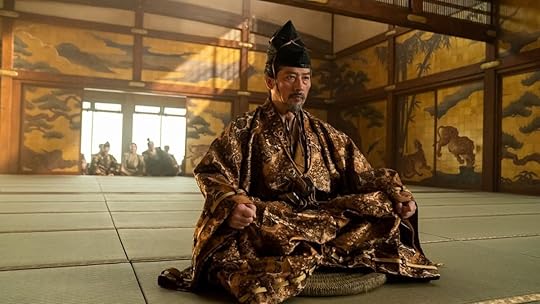 FX
FXFrederick H. Katayama, the moderator for the panel, aptly remarked that, unlike the 1980 Shōgun series, the FX series really brings Hiroyuki Sanada’s Lord Toranaga into center stage. It highlights his perspective and story. Of course, Sanada serves not only as the star of the series but as a very hands-on producer as well, bringing with him a wealth of valuable experience and deep knowledge of the subject matter.
He shared, “At first, I just got the offer as an actor to play Toranaga, but after Justin and Rachel joined the project, they asked me to do the producing as well. And I thought, oh my gosh, it’s going to be a great chance to introduce our culture to the world correctly, finally. So, I said, yes! And we’ve done our best with the western crew and cast and Japanese crew and cast working together to make everything authentic, as much as possible. It was a great experience for me.”
 FX
FXFellow star Anna Sawai echoed the importance of Sanada’s contribution to the authenticity of Shōgun. She noted, “He was always there. I don’t think I ever didn’t see him. Even on days where I was like, I would just want to do this on my own. He was always there. And that helped tremendously. Because I don’t know what I’m doing. And he does, he can point out the things I’m doing wrong. And not just him.”
Sawai revealed that the whole Shōgun Japanese team could make any changes they deemed necessary to promote an authentic story. Specifically, she recalled that Sanada even pointed out details in the background that were historically inaccurate, and Shōgun would accordingly shift whole sets and shots around.
 FX
FX“There are a lot of rules and customs, especially in the palace setting, driven by hierarchy and customs,” producer Eriko Miyagawa agreed, “So we were constantly having to adjust where would actors sit, where their attendants would sit, or how they would move when they have to deliver a letter to one of the characters. It’s small things, but everything has to be correct. And everything has to be vetted by our experts.”
 FX
FXSawai further shared another fascinating anecdote from the filming of Shōgun. She explained, “There’s nothing you can just casually do that was done in the 1600s; everything is just so different. Like… it was a scene with Hiro-san. And I guess I was looking at his eyes like a normal person when I was talking to him. And I was corrected that I shouldn’t be looking at his eyes, I had to be looking at his throat. I was like, what? How am I supposed to make a connection with this person I’m talking to and I’m not looking him in his eyes? But you start getting used to that stuff. And he was very patient with me.”
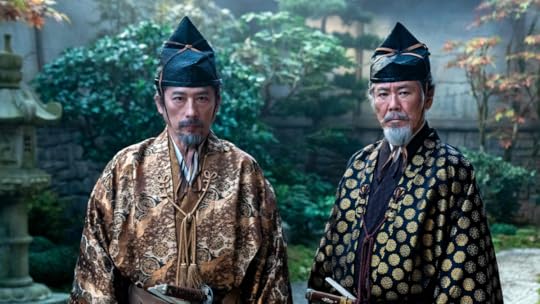 FX
FX“And it would extend to the broader macro question of what kind of crew we needed to bring from Japan. These are things from a Hollywood lens we don’t really know.” showrunner Marks noted. For instance, Marks revealed they flew an expert in from Japan to assist in tying the obi, a belt worn with the kimono or yukata. “It’s something that takes a lifetime to do well. And not just well, because here’s how it is. But also, here are the tricks. How can you tie it fast? How can you have it so you can remove it quickly? All of these are considerations that go through the production mechanism in Japan.” Kondo finished the thought by noting, “That was the theme of the production; we don’t even know what we don’t know.”
 FX
FXAdditionally, producer Eriko Miyagawa discussed the process of creating Shōgun from the perspective of script writing and translation. “It was a lot of collaboration. It was written, it was translated. Dialogue has to be as correct as it can be. And it has to capture all the beautiful lines written by the writers. So it was translated. And then it went to our wonderful Japanese polisher, who is based in Japan and has a lot of experience with Japanese period shows. So she would polish them and make them Japanese period, but also natural, realistic for human beings. That would come back to us, and we’d polish again and again.”
As a little spoiler preview, Marks shares that he cameos as a corpse in the first scene of the show. Meanwhile, Kondo and Miyagawa play “experienced prostitutes” in episode eight of Shōgun, roles they greatly enjoyed playing.
Ultimately, Sanada concluded about Shōgun, “We wanted to change the history of the Samurai drama. Not only for the world market, but even in Japan, too… We needed to create an authentic drama. Not only the history, the heart, acting, passion, emotion, all had to be real. Everything had to be organic on set and in front of the camera.”
You can now watch Shōgun‘s first episodes on FX and Hulu.
Rotem Rusak is a News Editor at Nerdist and absolutely loves a good historical drama, especially one with brilliant and authentic costuming.
The post FX’s SHŌGUN Series Focuses on Authenticity appeared first on Nerdist.
THE RINGS OF POWER Showrunners Begin Season 3 Work, Sign Overall Deal with Amazon MGM Studios
Season two of The Lord of the Rings: The Rings of Power does not even have a release date yet. But some news about The Rings of Power season three is already bubbling to the surface. A release sharing news of an overall deal inked by showrunners Patrick McKay and JD Payne hinted that work on season three has begun. It shared of future The Rings of Power chapters, “while a season three writers room has not yet opened, the showrunners have started to break the initial story outline.” Additionally, the announcement teased that Amazon expects The Rings of Power season two to debut “later this year.” Although it’s not much, eager fans of The Rings of Power chomp at the bit to hear any word from this The Lord of the Rings series.
 Prime Video
Prime VideoWhat does later this year mean? It’s hard to say. But hopefully, we’ll find out more sooner rather than later. In the meanwhile, it’s exciting to know that work on season three is already underway. Hopefully, the time we have to wait between The Rings of Power seasons two and three won’t be very extensive. As they work on seasons two and three, The Rings of Power showrunners have also officially signed an overall exclusive deal with Amazon MGM Studios. They have additonally created their own production company, 10:40 PM Productions.
“We began this remarkable journey with JD and Patrick more than five and a half years ago and have never looked back,” shares Vernon Sanders, head of television, Amazon MGM Studios. He adds, “We continue to be amazed by the scope and scale of their vision and the enormous global success achieved by The Lord of the Rings: The Rings of Power in its record-breaking first season. We can’t wait for Prime Video customers to experience the epic adventure and high-stakes drama that JD and Patrick are continuing to build throughout season two and beyond. Naturally, the studio is thrilled to extend our overall deal with these brilliant creative minds as they continue to deliver on their passion for great storytelling.”
 Prime Video
Prime VideoAnd all we have to say to Sanders is that we can’t wait to experience The Lord of the Rings: The Rings of Power season two and beyond either. So hopefully, as the story of season three comes together, the release date of season two comes to us. We’re ready for more Middle-earth adventures.
The post THE RINGS OF POWER Showrunners Begin Season 3 Work, Sign Overall Deal with Amazon MGM Studios appeared first on Nerdist.
Cyberpunk Classic NEUROMANCER Is Becoming a Series for Apple TV+
One of the most celebrated science fiction novels of all time is soon becoming a series for Apple TV+. Neuromancer, based on the iconic novel by William Gibson, will become a 10-episode series for the streamer. Many credit the 1984 novel for creating the cyberpunk genre. Others even cite the novel for coming up with the term “cyberspace” in the first place. Forty years later, it is finally getting a proper adaptation. This series comes from creators Graham Roland (Jack Ryan) and J.D. Dillard, with Roland serving as showrunner and Dillard directing the pilot episode.
 Apple TV+
Apple TV+According to the official series description, the story follows a damaged, top-rung super-hacker named Henry Case. He finds himself in a web of digital espionage and high-stakes crime with his partner Molly. A razor-girl assassin with mirrored eyes, Molly aims to pull a heist on a corporate dynasty with many untold secrets. Case soon comes in contact with a powerful A.I., decades before that term was in common use. Gibson followed up the original novel with two more in what he called “the Sprawl trilogy,” Count Zero and Mona Lisa Overdrive. It’s unknown if these 10 episodes serve as a self-contained season, or if the other books are part of this adaptation as well.
Neuromancer is famously the only sci-fi novel to win the Nebula Award, the Philip K. Dick Award, and the Hugo Award for an original paperback novel. Its influence is huge, and many have noticed its fingerprints on the themes and storylines of The Matrix. It’s the latest celebrated science fiction novel to receive the big-budget treatment as a series from AppleTV+, along with Isaac Asimov’s Foundation. No word yet on who will star in Neuromancer, or even when filming commences, but don’t expect to see the series on AppleTV+ before 2025.
The post Cyberpunk Classic NEUROMANCER Is Becoming a Series for Apple TV+ appeared first on Nerdist.
DOCTOR WHO’s Regenerations Have Never Been Normal
The third episode of Doctor Who’s 60th anniversary celebration, “The Giggle,” did something the show had never done before—a bigeneration! The Doctor always “regenerates” whenever one actor gives way to another, but it’s always a direct change, one to another. “The Giggle” split the Doctor into two, one David Tennant’s Fourteenth Doctor, and the other Ncuti Gatwa’s Fifteenth.
And as you can bet, fandom responded to this very rationally and with an open mind. Just kidding, they did the exact opposite. “But! The Doctor is the same person each time, there’s not two separate people! Time Lord biology doesn’t work that way! Why has this never happened before?! The Doctor’s regenerations are sacred and unchangeable.”
No, no they aren’t folks. In fact, I’m going to say something controversial: regeneration in Doctor Who has NEVER been the same, any of the times it happened. Why should now be any different? Let’s take out of the equation the fact that the show is fictional and Time Lords aren’t real to begin with, even within the context of the show it’s mainly suggestion based on what makes for good drama at the time. As long as Doctor Who has had regeneration rules, it’s looked for ways to break them.
Jump To: Doctor Who‘s First Regeneration // Doctor Who Regenerates Again // Regeneration in the ’70s // Tom Baker (Four)’s Regeneration // Regeneration Arrives in Modern Doctor Who // River Song and Regeneration // Doctor Who‘s 50th Anniversary Changed Regeneration Again // A New Cycle of Regenerations // Time Lord Regeneration Encompasses Race and Gender // Thirteen’s Regenerations // The Timeless Child // Bigeneration in Doctor Who // Doctor Who Regeneration Is Ever Changing
The First Regeneration on Doctor WhoRegeneration as a concept, only exists because William Hartnell, the actor playing the Doctor, was getting too old to remember the tome of lines the character had every week. And we’re talking 40-some episodes every season. Tons of episodes. But what to do when the character of the Doctor is the main focus of the series, and is seemingly unique? One idea in season three was to just…change the actor. Hey, he’s an alien, the show is science fiction! The story “The Celestial Toymaker” presented an opportunity for this godlike trickster to just make the Doctor look different for lolz. They didn’t do that, and good thing, too.
The replace-the-actor-in-continuity angle needed to be something replicable. Cut to “The Tenth Planet,” the story that introduced the Cybermen, and which Hartnell already sat out two full episodes. At the very end of the fourth episode, the Doctor wanders away from his companions, appearing in a lot of discomfort. He mutters something about his old body wearing thin. He then collapses on the floor of the TARDIS. What’s really interesting about William Hartnell’s transformation into Patrick Troughton is how sparse and inexplicable it is. The TARDIS groaning sounds play over it and the visuals flash in an out. It’s not entirely clear what’s even happening, or even that the TARDIS itself isn’t causing the transformation.
Doctor Who Regenerates AgainThe Second Doctor, three seasons later, was also wearing thin. Mostly, this was just Troughton getting tired. At the end of season six, Troughton’s final season, the wheels were coming off the production cart a little bit. So much so that the final serial, “The War Games,” just kept ballooning as they were making it in lieu of any other usable scripts. It went from four episodes into the eventual 10 episodes, the second longest single serial in the show’s history.
Partway through the serial, the Doctor meets a character called “The War Chief,” who turns out to be another member of the Doctor’s race. We’d met other such characters before but with the War Chief, we learn for the first time the name of the Doctor’s race—the Time Lords. Despite running from them since the show began, things get so bad that the Doctor has no choice but to signal to the Time Lords to intervene, giving himself up in the process.
The Time Lords put him on trial for the horrible crime of helping people and so decide to exile him to Earth, removing his ability to fly the TARDIS, and forcing his face to change. The Time Lords don’t say “you’re going to regenerate, a thing we all do all the time.” Rather they say “your face has changed before, it will change again.” Unlike “The Tenth Planet,” we don’t actually see the Second Doctor turn into the Third Doctor. Once again it’s not clear if this is a thing that his body can do normally and they’re just forcing it, or if it’s a punishment that wouldn’t have happened otherwise.
Regeneration in the ’70sBeginning with the Third Doctor, we get the word “regenerate” in relation to the Doctor changing shape. This would begin major lore creation for the series with regards to Time Lords. The Third Doctor’s change proved it was something Gallifreyans had the ability to do. However, it remained unclear whether this is something all Time Lords do or just something Time Lords can do.
That all changed during the Tom Baker era. In the now classic story “The Deadly Assassin,” the Fourth Doctor returns to Gallifrey in order to foil an assassination plot against the Time Lord president. Along the way, the Doctor discovers it’s the Master, decrepit and decaying at the end of his life cycles, trying to utilize the Gallifreyan citadel’s mystical Eye of Harmony to give him a new set of regenerations. One of the Doctor’s allies says “After a Time Lord’s twelfth regeneration, nothing can save them.”
 BBC
BBCThis was, in no small way, massive. After 13 years on the air and three onscreen regenerations, the show slaps us with lore that, whether by nature or design, Time Lords can only regenerate 12 times, meaning 13 separate lives. Retroactively, the show tells us the first two Doctors did in fact properly regenerate, and moreover, they’d put a number on it.
Now, in fairness to writer and script-editor Robert Holmes, it seemed HIGHLY unlikely at the time the Doctor would ever need to worry about this. Since we live in the future, it saddled Doctor Who with storytelling limitations that future writers would have to try to figure out how to deal with.
Tom Baker’s Regeneration Had a Time GhostAfter a whopping seven seasons in the role, Tom Baker’s scarf began to unravel for the last time. His final story, “Logopolis” is about entropy and a planet run by math. I do not want to explain it further. Throughout the story, the Doctor and companions keep seeing this weird ghostly figure watching them. This thing just stands around and the Doctor seems to know what it is but won’t say.
As the story comes to a close, and the Doctor falls from a great height after defeating the Master, he says “it’s the end, but the moment has been prepared for.” The then gestures to the white alien thing who walks over and like, merges with the Doctor’s body which triggers the regeneration. Nyssa has the ADR’d line “The watcher…he was the Doctor all the time.”
Hang on. So this weird ghost was a spectre of the Doctor’s next incarnation? Like, tapping his watch? “Come on, curly, we’re burning daylight here.” Why does this happen? How does this happen? And how did Nyssa, who literally only showed back up an episode prior, know all about how Time Ghosts work?
Jump To: Doctor Who‘s First Regeneration // Doctor Who Regenerates Again // Regeneration in the ’70s // Tom Baker (Four)’s Regeneration // Regeneration Arrives in Modern Doctor Who // River Song and Regeneration // Doctor Who‘s 50th Anniversary Changed Regeneration Again // A New Cycle of Regenerations // Time Lord Regeneration Encompasses Race and Gender // Thirteen’s Regenerations // The Timeless Child // Bigeneration in Doctor Who // Doctor Who Regeneration Is Ever Changing
Doctor Who Made Regeneration a Rule…and Then Broke ItThe next several regenerations were all weird in their own way. The Fifth turned into a guy he’d met before. Number Six regenerated from hitting his head on the TARDIS console. The Seventh Doctor was gunned down by Triad gangs in the 1996 TV movie on Fox. They bent the rules but never broke them. By time the series returned in 2005 under Russell T Davies, regeneration had been fully codified into Doctor Who‘s DNA.
However, following the Ninth Doctor’s regeneration into the Tenth, things got a bit more complicated. “The Christmas Invasion” finds the newly minted Tenth Doctor in bed for most of the adventure, cooking after regenerating. When he finally gets up, he runs his gob and has a sword fight with a bad alien skull had man. During the fight, the baddie cuts his hand off, but because he’s still in the first 12 hours of his regeneration cycle, he grows a new one.
In the cliffhanger to the previous episode, “The Stolen Earth,” a Dalek zaps the Doctor in the heart and he starts to regenerate. The viewing public knew David Tennant was leaving the show so it was a great and shocking surprise. However, the first seconds of “Journey’s End” has the Doctor heal his wounds with the regeneration energy and then shoot the rest off into his severed hand, which has been in the TARDIS in a water-filled specimen tank after Torchwood found out and Captain Jack Harkness brought it back to him.
This makes the hand grow into a separate version of the Doctor but—and this is a big thing—is a one-hearted, non-regeneratable human. All of this was basically to give Rose Tyler, who was full-on in love with the Doctor but got banished to another dimension, a boyfriend. It’s so weird. It’s SO weird.
Fans call him “The Handy Doctor.” Presented without commentary.
The Wild Saga of River SongSeries 6 is a whole thing which is very complicated and deals with the origins of girl-out-of-time River Song. It turns out River is actually the daughter of the first married couple companions, Amy and Rory. We learn that she can regenerate and was kidnapped as a baby and programmed to be an assassin to kill the Doctor. Why can she regenerate? Well, the show tells us since she was conceived in the TARDIS while it was traveling through the time vortex, the baby was somehow fused with Time Lord DNA.
 BBC
BBCIn the series’ eighth episode, “Let’s Kill Hitler,” we find that the Doctor is for-sure going to die but then River bestows upon him her remaining regenerations through a kiss. So she’s a regular ol’ human person now, but the Doctor is back to having the same exact amount of regenerations he was already up to.
Doctor Who‘s 50th Anniversary Changed Regeneration AgainThe 50th anniversary was the first multi-Doctor story, really, since the ‘80s and brought back David Tennant to team up with Matt Smith, and folks, it’s so good. But, for our purposes, it also has some very particular things to say about regeneration.
At the end of the previous series, the Doctor and his companion Clara Oswald end up within the Doctor’s own time thread, and they see versions of all his previous selves. One of them is unknown to Clara, who had met all the ones we’ve talked about. The Doctor says “We don’t talk about that one,” whose name is apparently Bruno.
The cliffhanger shows John Hurt, and it says introducing John Hurt as the Doctor. And my dudes, people lost their damn mind. How can this be!? He’s not one of the canonical Doctors! The numbering! Think of the numbering!
This was all part of the wild mix of necessity and contractual requirements writer Steven Moffat had to contend with. The new series, and especially the Moffat era, had made sure to confirm in continuity that the Eleventh Doctor was, in fact, the Eleventh Doctor. But because the presumed Doctor to fight in the Time War—the Ninth Doctor—was played by an actor who did not want to return, Moffat had to figure something else out. Moffat created a new Doctor that fit in between the Eighth and Ninth, who didn’t count himself as a Doctor. The War Doctor.
What Regeneration Limit?In the very next episode, “The Time of the Doctor,” Matt Smith’s Eleventh Doctor strands himself on the planet Trenzalore, protecting the town of Christmas for hundreds of years. He gets markedly ancient and then he explains to Clara that he’s out of regenerations. He counts them thusly: Each regen we see from 1-7, then Eighth Doctor to War, then War to Ninth, Ninth to Tenth, then Tenth to Handy Tenth, then Tenth to Eleventh. So he’s out of regenerations, apparently.
Lucky for him, he finds his home planet in a crack in time and through that, the Time Lords bestow on him a new cycle of regenerations.
People were mad about this. That’s a get out of jail free card, a deus ex machina, a third trope that means the same thing. My response is: Yeah, of course it is. Do you want the show to be over? If you never change canon, if you never think of clever ways out of painting yourself in a corner, or a corner someone else painted you in 40 years prior, then you can’t keep a series going for 60 years. Feel free to stop watching and make your head canon that the Doctor died and we’re done. But we’re not done.
Jump To: Doctor Who‘s First Regeneration // Doctor Who Regenerates Again // Regeneration in the ’70s // Tom Baker (Four)’s Regeneration // Regeneration Arrives in Modern Doctor Who // River Song and Regeneration // Doctor Who‘s 50th Anniversary Changed Regeneration Again // A New Cycle of Regenerations // Time Lord Regeneration Encompasses Race and Gender // Thirteen’s Regenerations // The Timeless Child // Bigeneration in Doctor Who // Doctor Who Regeneration Is Ever Changing
Time Lord Regeneration Encompasses Race and Gender TooAfter the Twelfth Doctor era, the Doctor changes genders for the first time on screen, going from Peter Capaldi to Jodie Whittaker. This was a pretty groundbreaking moment, however to quote a previous regen, “The moment had been prepared for.”
Earlier in the Eleventh Doctor era, we hear about a friend of his named the Corsair who had changed gender upon regeneration. Then there’s Missy, of course, a female-presenting version of the Master. And just for good measure, in the story “Hell Bent,” the Doctor shoots a Time Lord general who then regenerates from Ken Bone, and old white man, into T’Nia Miller, a younger Black woman.
Wild Thirteenth Doctor ShenanigansIn the episode “The Fugitive of the Judoon,” the Doctor works to protect a woman named Ruth played by Jo Martin from being unduly captured by the intergalactic rhino police guild, the Judoon. As the episode goes on, we eventually learn, along with the Doctor, that Ruth is a version of the Doctor in hiding who had used a chameleon arch to wipe her memory and make her human. Naturally the Doctor assumes this is a later incarnation, because she doesn’t remember this version, but the Ruth Doctor also doesn’t remember the Thirteenth Doctor. So, a mind-wiped future incarnation? NO.
 BBC
BBCWe learn that Doctor Ruth (not the sex one) was a pre-Hartnell Doctor whom Division, which is basically the Time Lord CIA, the government of Gallifrey used to carry out clandestine murder missions. At some point, we’re further led to believe, the Doctor’s memory was fully wiped, given a full new set of regenerations, and as far as they were concerned, they were living their first life.
Now this is obviously a huge, huge revelation. If you thought the War Doctor mucking up the 1-11 numbering was a problem, try not even knowing what number this new one is! Is she Doctor Zero? Is she negative numbers Doctor?
The Timeless ChildThe Thirteenth Doctor hardly gets time to wrap her head around this before she gets a whole new wallop of backstory. The Master, ever the thorn in the side of things, has wiped out the citadel on Gallifrey, because he learned a fact he couldn’t handle. Eons ago, a Gallifreyan scientist named Tecteun found a strange child that seems to have come out of nowhere. This child has the innate ability to turn into a new person on the genetic level whenever they die. And yes, a child dies on Doctor Who.
Tecteun then figures out a way to harness this energy and give it to other Gallifreyans to keep them alive for millennia longer than they otherwise would have been. Simultaneously they’d developed time travel, so couple with effective immortality, they became the Time Lords.
Time Lord government imposed the 12 regeneration limit, because who wants to live forever, as Freddie Mercury once said. The child, if you hadn’t figured it out yet, was the Doctor, who was not only exploited for their natural resource, but forced into servitude in the Time Lord CIA who basically used them as a Winter Soldier, mind-wiping and regenerating them after every mission.
The amount of rewriting to lore this creates is gargantuan, not to mention it brings into question all of the times throughout the years we’ve heard the Doctor muse about their childhood on Gallifrey. Did they turn the Doctor back into a child when Division was done with them? Because we know from the Twelfth Doctor episode “Listen” that the Doctor was a child living in a barn at one point. We also know they grew up and went to school with the Master, so again I ask, how and why?
One Face, Two Face, Old Face, New Face: Bi-Generation in Doctor WhoEventually, the Thirteenth Doctor’s time arrived. She stands on a mountain and regenerates into…David Tennant?! Well, it’s not unprecedented at this point! It’s canonically a new Doctor, the Fourteenth, but he’s reusing the Tenth Doctor’s face a) because it’s for anniversary special reasons, and 2) so once and future showrunner Russell T Davies can right some wrongs with the character of Donna. And we already know revisiting faces is a thing.
Which brings us, finally, to “The Giggle,” the third of the three Doctor Who 60th anniversary specials.
 BBC
BBCThe Toymaker, the trickster god from another plane of existence and who has powers of reality manipulation, zaps the Fourteenth Doctor and he starts to regenerate again. But no! He doesn’t regenerate, at least not quite. He asks Donna and returning Sixth and Seventh Doctor companion Mel Bush to pull on his arms and this splits him in two, with one remaining David Tennant and the other the trouserless Ncuti Gatwa, the Fifteenth Doctor.
The show makes a point of explaining this has never happened before, it’s new and unique due to the Toymaker’s reality manipulation. It’s not a re-generation, it’s a bi-generation. There are now two Doctors, the former of which seemingly mortal.
And you wanna know something? I love it. I think it’s genius. Why, why, why keep doing the same damn thing you’ve been doing for 60 years? Especially when, basically all of those previous examples were not “the same” in any way?
Jump To: Doctor Who‘s First Regeneration // Doctor Who Regenerates Again // Regeneration in the ’70s // Tom Baker (Four)’s Regeneration // Regeneration Arrives in Modern Doctor Who // River Song and Regeneration // Doctor Who‘s 50th Anniversary Changed Regeneration Again // A New Cycle of Regenerations // Time Lord Regeneration Encompasses Race and Gender // Thirteen’s Regenerations // The Timeless Child // Bigeneration in Doctor Who // Doctor Who Regeneration Is Ever Changing
Doctor Who Regeneration, Now and ForeverRegeneration was one of the most brilliant conceits a TV production ever dreamt up. You might be able to get away with recasting a character once and have the audience buy it. But only Doctor Who has built it into the fabric of the show. Change is the show’s key to longevity. Updating the cast every few years, bringing in not only new companions but a new Doctor who is the same Doctor but not, keeps the series fresh.
There’s a reason the first episode of a new Doctor is routinely the most watched of any era. People are excited about how the new person will be in the role. And that’s still what’s happening. Nothing is different on that front. We’re still getting brand new adventures with a new actor in the lead. So what if now they have no regeneration limit or the Doctor can split rather than fully change?
A younger me would have been annoyed by this but I also have changed with the times. As long as we’re still getting a show that’s willing to take weird risks and swing for the fences, even if they don’t make sense, I say go for it. If you can justify it and make it resonate with the characters, I’m here for it.
Kyle Anderson is the Senior Editor for Nerdist. He hosts the weekly pop culture deep-dive podcast Laser Focus. You can find his film and TV reviews here. Follow him on Instagram and Letterboxd.
The post DOCTOR WHO’s Regenerations Have Never Been Normal appeared first on Nerdist.
Doctor Who’s WEIRD History of Regeneration
The newest incarnation of the Doctor is here, and Ncuti Gatwa’s surprising method of arrival has stirred fan uproar. Thankfully Nerdist’s resident Doctor Who expert is hopping in his T.A.R.D.I.S. to take a look back at the long and weird history of regeneration in the show, and break down how it’s actually never made much sense.
More Doctor Who News: https://nerdist.com/topic/television/
Watch more Nerdist News: http://bit.ly/1qvVVhV
Follow Us:
Facebook https://facebook.com/nerdist
Twitter https://twitter.com/Nerdist
Instagram https://instagram.com/nerdist/
TikTok https://www.tiktok.com/@nerdist
Image: BBC
The post Doctor Who’s WEIRD History of Regeneration appeared first on Nerdist.
SUITS Spinoff, SUITS LA, Reveals Lead Cast
Suits seems to be the topic of many recent conversations, even though it has been off the air for quite some time. That fact hasn’t stopped the USA show from dominating streaming charts, though. Suits has landed at number one on the Nielsen Streaming Top 10 more than any other series. So, it’s no surprise that networks have taken note. And now, NBC has greenlighted a pilot for the Suits spinoff series Suits: LA. Arrow star Stephen Amell will serve as the lead in this spinoff alongside Lex Scott Davis. We’ll see if lightning can strike twice.
 USA
USAHere’s what Variety had to share about the Suits spinoff series. It notes that Suits: LA will follow Ted Black “a former federal prosecutor from New York, who has reinvented himself representing the most powerful clients in Los Angeles.” And further adds that the spinoff logline reveals. “His [Ted Black’s] firm is at a crisis point, and in order to survive he must embrace a role he held in contempt his entire career. Ted is surrounded by a stellar group of characters who test their loyalties to both Ted and each other while they can’t help but mix their personal and professional lives. All of this is going on while events from years ago slowly unravel that led Ted to leave behind everything and everyone he loved.”
 The CW
The CWDeadline reports that Stephen Amell has been cast as the lead in Suits LA and will play the aforementioned Ted Black. The publication further adds that “Ted Black is described as a charismatic force of nature who puts his own needs above others. Fifteen years ago, the former New York prosecutor joined forces with his old buddy, Stuart Lane, to build an L.A. law firm that specializes in criminal and entertainment law.”
Additionally, Variety shares that Suits LA has cast Lex Scott Davis in a lead role. According to the publication, Davis will play “Erica Rollins, described as “a savvy and strong-willed rising star. Erica works for Ted Black. She’s shrewd enough to test the loyalty of her associates only to admire some of them for not having any.” Josh McDermitt has also reportedly come aboard the Suits spinoff. He is said to play the “energetic, powerful and self-absorbed…Stuart Lane, who co-founded Black Lane Law.”
 Universal Pictures/AMC
Universal Pictures/AMCAs of now, there is no further cast information available. Could Meghan Markle return in this Suits offshoot? That would really be something. We’d also love to see more from Gina Torres. We’ll have to wait and see. What we do know is that this spinoff is in good hands, with Suits’ original creator returning to write and executive produce.
It’s an interesting time for the once-dominant USA set. Monk got a revival movie in late 2023, Mr. Monk’s Last Case: A Monk Movie. And now, Suits will return to the courtroom in this spinoff. Personally, we have to vote for a White Collar renaissance next. The time has come to let Neal, Peter, and Elizabeth live happily ever after together. In the meanwhile, we’ll keep our eye peeled for more from Suits: LA.
Originally published on February 2, 2024.
The post SUITS Spinoff, SUITS LA, Reveals Lead Cast appeared first on Nerdist.
TEENAGE MUTANT NINJA TURTLES: MUTANT MAYHEM Sequel Sets 2026 Release Date
The new Teenage Mutant Ninja Turtles animated film Mutant Mayhem made quite a splash. However, before it was even released, Paramount felt very confident in it. The studio revealed plans for a two-season series that will bridge the gap between Mutant Mayhem and its greenlit sequel. This new sequel movie doesn’t have a name yet, but the streaming show has the title Tales of The Teenage Mutant Ninja Turtles. The series will release in summer of 2024. And the Teenage Mutant Ninja Turtle: Mutant Mayhem sequel will arrive on October 9, 2026.
 Paramount Pictures
Paramount PicturesJeff Rowe, who also directed and co-wrote Mutant Mayhem will direct the movie sequel. Chris Yost (The Mandalorian, Thor: Ragnarok) and Alan Wan (Rise of the Teenage Mutant Ninja Turtles and the 2012 Teenage Mutant Ninja Turtles series) will serve as executive producers and showrunners. Lukas Williams will oversee both the series and sequel for Point Grey Pictures. This is the company of Seth Rogen and Evan Goldberg, who’ve also brought us The Boys and soon, Gen V. The last few live-action projects with the Turtles didn’t land as expected. It seems Paramount is really looking at animation as the Turtles’ future.
 Nickelodeon Animation/Paramount+
Nickelodeon Animation/Paramount+Returning from Mutant Mayhem for the Paramount+ series are Micah Abbey, Shamon Brown Jr., Nicolas Cantu, and Brady Noon as the turtles. According to the official description for the series, the heroes in a half shell will be challenged like never before. Leo, Raph, Donnie, and Mikey each choose to forge a path alone for the first time. New dangers will await them, but they’ll also reunite with old friends to take on new threats. The Turtles will discover who they really are when they don’t have their brothers at their sides.
The new streaming series will premiere in summer of 2024, just in time for the Turtles’ 40th anniversary. And we’re excited to see Mutant Mayhem‘s sequel in 2026.
Originally published on July 26, 2023.
The post TEENAGE MUTANT NINJA TURTLES: MUTANT MAYHEM Sequel Sets 2026 Release Date appeared first on Nerdist.
Who Is Kang the Conqueror? The Marvel History of the MCU Villain, Explained
Forget Thanos, Ultron, and Loki. In the pages of Marvel Comics, the Avengers’ biggest adversary was always Kang the Conqueror. And after years of waiting, he arrived in the MCU on Loki, played by Jonathan Majors. Marvel’s Kang the Conqueror appeared in full villain mode in the MCU’s Ant-Man and the Wasp: Quantumania and then in season two of Loki. These appearances were supposed to be the warm-up act for Kang to unleash chronal hell in Avengers: The Kang Dynasty. However, Marvel fired Jonathan Majors from the role and Kang’s future in the MCU is currently unknown. However, if you’re curious about: who is Kang the Conqueror from the Marvel universe, we take a look at his complex comic book history.
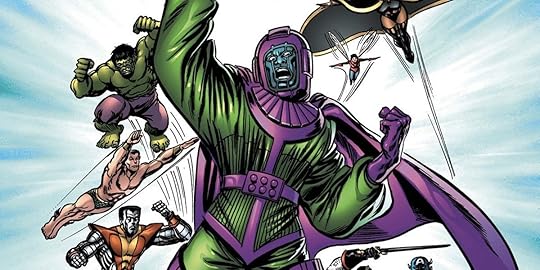 Marvel ComicsJump to: Kang’s Origins // The Many Kang Variants in Marvel Comics // Kang and the MCU When Does Kang the Conqueror First Appear in Marvel Comics?
Marvel ComicsJump to: Kang’s Origins // The Many Kang Variants in Marvel Comics // Kang and the MCU When Does Kang the Conqueror First Appear in Marvel Comics? Despite primarily being an Avengers villain, the Stan Lee/Jack Kirby creation Kang first appeared in the pages of Marvel’s Fantastic Four. This detail made him a part of the Fantastic Four film rights, and therefore, it wasn’t until Disney purchased Fox that Marvel Studios could use him properly. Kang the Conqueror’s first appearance was in 1963’s Fantastic Four #19, as the Pharaoh Rama-Tut. Kang wouldn’t appear in a more recognizable Marvel form until a year later, in 1964’s Avengers #8. But let’s begin at the beginning, which in this case, means ancient Egypt, by way of the 31st century.
Kang the Conqueror’s Path From Fantastic Four Villain to Avengers Adversary Marvel Comics
Marvel ComicsKang is complicated to explain, thanks to the many, many variants of him across multiple Marvel timelines. For the purpose of clarity, we’re going to focus on what they call “Prime Kang,” and we’re going to focus on this Kang’s chronological Marvel appearances. Nathaniel Richards, who may or may not be a descendant of the Fantastic Four’s Reed Richards and Doctor Doom, was born as a human male in 31st century Earth. As a young man, he discovered his ancestor Doctor Doom’s time platform, which he used to travel to ancient Egypt.
 Marvel Comics
Marvel ComicsHe conquered this past era and became the Pharaoh Rama-Tut. But a time-traveling Fantastic Four defeated him and sent him packing to the far-flung future. This war-ravaged 40th century Marvel Earth the soon-to-be Kang landed in, 1,000 years further from his birth era, utilized technology the population no longer understood. So Richards used his scientific knowledge to conquer this time period and became Kang the Conqueror. Kang had no superpowers to speak of, but he had a genius intellect and access to all time periods. This allowed him to access almost godlike technologies.
 Marvel Comics
Marvel Comics But the 40th century was not enough for him, and Kang decided to conquer other eras as well, with the goal of eventually ruling over all of history. This is when he came into conflict with the Avengers. As a young man, Kang the Conqueror was obsessed with Earth’s “Heroic Age,” and saw them as the only ones who could stop him. So Kang traveled to the past to destroy the Avengers. This marked the first of literally dozens of times combatting Earth’s Mightiest Heroes. Kang was more of a master strategist than Thanos, but despite incredible power, he wasn’t on the level of the Celestials—despite trying to steal their technology once.
Jump to: Kang’s Origins // The Many Kang Variants in Marvel Comics // Kang and the MCU The Many Identities and Variants of Kang in the Marvel Universe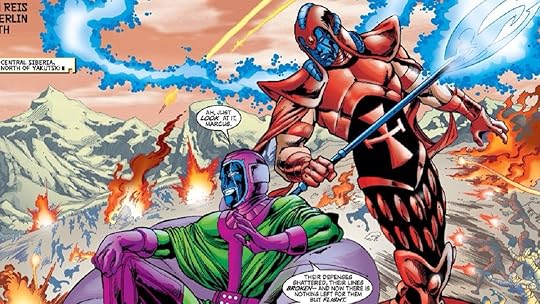 Marvel Comics
Marvel ComicsEventually, Kang time-traveled so much in Marvel Comics that multiple variants of himself spread across spacetime. If one Kang died, another always existed in an alternate timeline to cause trouble. One version of Kang went by the name the Scarlet Centurion, an identity he adopted after his time in ancient Egypt, but before becoming the Kang we know—even though the Kang identity appeared in Marvel Comics first.
Those are all just the tip of the iceberg when it comes to Kang variants. In one story, he traveled back to the early 1900s and took the name “Victor Timely,” and built a small town in Wisconsin from which he could alter the flow of time. In the year 2099, he was the owner of a large company known as “Kang the Conglomerator.” In the 21st century, another CEO-style variant of Kang went by Mr. Gryphon. He even melded once with Ms. Marvel and became “Kamala Kang.”
 Marvel Comics
Marvel ComicsOn Earth-18854, Kang took the power of Galactus himself and became “Kang the Time Eater.” Because of his control of time, he may even be more powerful than the Celestials themselves. Not all of Marvel’s Kangs were totally cold and power-hungry, however. One fell in love with one of his subjects, a woman named Princess Ravonna. In one timeline, they even had a son together named Marcus. He would assume a former alias of his father’s, the Scarlet Centurion.
Immortus, the Most Dangerous Kang Variant Marvel Comics
Marvel ComicsBut the version of Kang the Conqueror the Avengers tangled with the most was Immortus. This was a much older version of Kang. After having conquered timeline after timeline, Kang grew weary of battle. The alien race called the Time-Keepers approached him. They were time travelers from the end of the universe and the last living creatures known to exist. Kang became their agent and began preserving Marvel’s timelines instead of conquering them. He did all of this for the Time-Keepers, in exchange for immortality (hence the new name). The former Kang accepted and reinvented himself again, this time as Immortus, the lord of the other-dimensional realm of Limbo.
 Marvel Comics
Marvel ComicsBut conquering timelines and pruning them are also aggressive acts—just not in the same way the younger Kang was prone to. All of this constantly brought Immortus into conflict with the Avengers. Although this Kang variant did officiate at the wedding of Vision and Scarlet Witch. Speaking of Wanda Maximoff, Immortus was later revealed to be the one behind the Scarlet Witch’s dark side turn in Marvel’s comics. Kang’s manipulations caused all the tragic events in her life. He didn’t only Wanda; Immortus’ hand lead to a teenage Tony Stark’s death in the ‘90s as well. (Don’t worry, he got better.)
 Marvel Comics
Marvel ComicsIn the comics, we even saw a “Council of Cross-Time Kangs,” made up of hundreds of Kang variants from across the multiverse. But Marvel later revealed this Kang Council to be a trap of sorts, one made by Immortus to slowly eliminate all variants of himself to ensure that only he remained at the literal end of time. Confused yet? We know, it’s a lot. And that’s without getting into how Kang once manipulated time to fight the X-Men and the crew of Star Trek: The Next Generation. Yes, that is an event that happened back in the ’90s.
That Time Kang Was an Avenger Marvel Comics
Marvel ComicsThe most intriguing version of Kang first appeared in 2005, and readers didn’t even know it was Kang at first. After the Avengers broke up (in the pages of Avengers: Disassembled), a young hero named Iron Lad appeared. He wore an advanced version of Tony Stark’s armor, one that was neuro-kinetic in nature. When teen Kang discovered what his dark destiny had in store for him, he fled back in time to seek the Avengers for protection. He landed at a point in time when the team had split up, so this Kang used his know-how to assemble Marvel’s Young Avengers team. Eventually, he realized he must return to his own time and fulfill his destiny and become a villain, or he’d damage the timestream even more.
Jump to: Kang’s Origins // The Many Kang Variants in Marvel Comics // Kang and the MCU The MCU’s Version of Kang, a.k.a. the Time Tyrant in Ant-Man and the Wasp: Quantumania and Phase 6 Marvel StudiosLoki‘s Kang and Ant-Man’s Kang in the MCU
Marvel StudiosLoki‘s Kang and Ant-Man’s Kang in the MCULoki introduced us to “He Who Remains” as the last version of Kang who ruled from his Citadel at the End of Time. He explained how his variants all went to war with each other, leading to a huge multiversal conflict. He warned Loki and his variant Sylvie that if they killed him, it would ignite another multiversal war. When Sylvie ended him, the multiverse ripped open again.
 Marvel Studios
Marvel Studios Loki had another nod to the comic book Kang’s Marvel history. This one had to do with one of the TVA agents, Ravonna Renslayer. She was based on Kang’s great love from the comics. Another way “He Who Remains” echoed Marvel’s comics was with his elimination of other Kangs and their timelines. This was very Immortus-like. But now that Loki‘s Kang is dead, we’ll likely see his much more destructive MCU variants spread chaos throughout Marvel’s Multiverse.
Lord of the Quantum Realm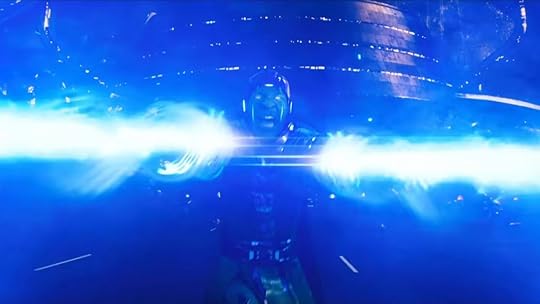 Marvel Studios
Marvel StudiosIn Ant-Man and the Wasp Quantumania, we learned the Kang we met in the Quantum Realm was exiled there by his other variants, essentially for being worse than the rest of them. There, he met the also-lost Janet Van Dyne (Michelle Pfeiffer). At first, they were seemingly friends, and she tried to help fix his time chair to get home. But when she learned that he had conquered countless timelines and destroyed them, she turned on him. Janet tried everything she could to stop him from ever getting out. She even aided in the rebellion against him when he conquered the Quantum Realm. After she returned to the Quantum Realm, along with her husband, daughter, and Scott and Cassie Lang, they stopped Kang from escaping again. They also toppled his microverse empire.
Is Kang Still in the MCU’s Future?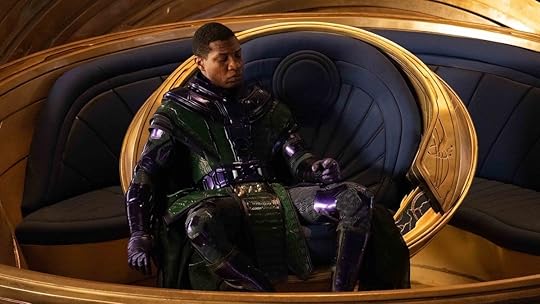 Marvel Studios
Marvel StudiosIt looked like Scott and Hope killed Kang in the finale of Quantumania, but he possibly disappeared into another time period. The end-credits revealed the Council of Kangs, and introduced Immortus, Rama-Tut, and a version of Scarlet Centurion, all infamous variants of Kang—not to mention hundreds of others we saw in the Council. Loki season two, of course, featured Kang prominently.
However, Kang the Conqueror’s MCU future is unknown with some reports saying Avengers: The Kang Dynasty will be getting a new title.
Jump to: Kang’s Origins // The Many Kang Variants in Marvel Comics // Kang and the MCUOriginally published on August 1, 2022.
The post Who Is Kang the Conqueror? The Marvel History of the MCU Villain, Explained appeared first on Nerdist.
A Brief(ish) History of Blaxploitation Horror Movies
The Blaxploitation film era is, for better or worse, a cornerstone in the foundation of modern Black history. The subgenre, a portmanteau of Black and exploitation, came at critical time between the late 1960s when social turbulence and Black Pride intertwined and the 1970s era of superfly style, disco and funk music, and the continued reign of the all-mighty Afro. Blaxploitation gave audiences films that centralized our communities and made us the protagonists, infusing our stories with socioeconomic commentary Black slang and music, Black fashion, and much more.
 American International Pictures
American International PicturesMany of the behind-the-scenes creatives were also Black, at times putting a realistic eye on their content. Their work was not without controversy from some prominent Black leaders about how these stories reflected the collective. To be fair, not every portrayal shined a positive light on Black communities. However, this explosion soon led to Hollywood’s continuous capitalization and curious outside eyes. A flurry of stories that were, well, exploitative and leaned into harmful stereotypes about Black people came about. (I’m looking directly at Dino De Laurentiis’ Mandingo.) These non-Black filmmakers and directors would take any story and “Blacken it up,” usually to the point of pure nonsense.
Blaxploitation’s meteoric rise and decline took place in the same decade. But its influence continues to resonate in Black media of all genres. Most people rightfully point to films like Shaft, Sweet Sweetback’s Baadasssss Song, and Foxy Brown as the pivotal films of this genre with a profound influence on their descendants. But Blaxploitation horror is arguably just as important with stories centered around crimes, rituals, and period drama with supernatural narratives. Oftentimes, exploring the full scope of what it meant to be a Black American during this time period—or any time period, honestly—involved some aspect of horror, even if it was only clear to the intended audience. Let’s explore the history of a few pivotal (and maybe not-so-great) Blaxploitation horror films.
When you consider the scope of filmmaking in any genre from decades past, it is often hard to pinpoint definitive “firsts.” We tend to largely filter genres through a mainstream or highly-lauded indie perspective, so many films fly under our radars. Who knows if an indie filmmaker made a lost-to-time Blaxploitation horror in, say, 1967? But, we do know that one of the earliest Blaxploitation horror films is also one of the most successful films of this era, period.
William Crain’s brilliant Blacula (1972) is more than just a “Black Dracula.” It makes a profound metaphorical connection between slavery and vampirism through Mamuwalde’s misfortunes. He is a wealthy African prince who goes to Transylvania to petition Count Dracula to stop the slave trade. In return, Dracula refuses to comply, bites him, and curses him with the name Blacula. He’s resurrected in the 1970s and falls in love with Tina, a Los Angeles native.
At this time, horror was only a couple of years from giving birth to a golden age of slashers. Filmmakers leaned heavily into remakes in the early 1970s, including several Dracula flicks. So, taking that trend, putting Black people on both sides of the camera, and crafting a moving horror film with a love story undercurrent struck the perfect nerve. There were imitators, like the rightfully panned Blackenstein (1973), but zero duplicators. The Black vampire energy continued to permeate the air with a slightly less successful sequel, Scream Blacula Scream (1973). In 2021, plans for a Blacula reboot were underway.
 Kelly-Jordan Enterprises
Kelly-Jordan EnterprisesBut the true standout Blaxploitation horror film of 1973 was Bill Gunn’s Ganja & Hess, a moody vampire film that dances with some tenets of Blaxploitation films like dealing with “The Man,” overt sexuality, and Afrocentrism. Night of the Living Dead’s Duane Jones starred as Dr. Hess Green, a wealthy anthropologist whose assistant stabs him with an ancient ceremonial dagger. Hess becomes a vampire as a result and falls in love with Ganja (Marlene Clark), his assistant’s widow. Ganja & Hess is a smart and sexy film with themes of assimilation, respectability politics, and more through the ebb and flow of the protagonists’ relationship. While Ganja can be perceived as the stereotypical “seductress,” there’s more depth to her character that she likely wouldn’t have gotten if written from a non-Black perspective.
Overall, Ganja & Hess resides on the more favorable side of Blaxploitation offerings. The film’s off-screen journey took a strange turn when its producers sold it to Heritage Enterprises. The company drastically recut the movie and packaged it as Blood Couple. I suppose the new owners thought it was a little too “smart” for audiences. Needless to say, Gunn wasn’t happy about the chopping of his movie, which was thankfully preserved in its original format. Ganja & Hess continues to resonate with modern audiences, from thoughtful examinations for its 50th anniversary to a discussion of the film in the documentary Horror Noire. Famed director Spike Lee’s remake of the film, Da Sweet Blood of Jesus, brought it to a new generation’s attention in 2014, with many agreeing that there’s nothing quite like the original.
This film set off a deliciously dark and creative spark that carried into 1974 with more Blaxploitation horror films. In fact, two of them came to us courtesy of American International Pictures (AIP). There’s the wildly silly yet enjoyable Abby, which follows a woman who is possessed by (or, depending on how you interpret it, influenced by) a West African spirit of chaos and lust. (The creators’ limited understanding of orishas is slim to none, obviously.) And that’s exactly what this film dishes out in ample amounts as Abby Williams (Carol Speed) becomes a hypersexual one-woman wrecking crew—a lifestyle not befitting of a preacher’s wife. (Abby also stars William Marshall, a.k.a. Blacula himself, as Abby’s archaeologist father-in-law.)
Abby became a financial success; however, it ran into a legal issue with Warner Bros. claiming it was far too similar to The Exorcist and therefore violating a copyright. There’s a noticeable influence but Abby’s writer G. Cornell Layne and producer/director William Girdler didn’t copy every single test answer. Still, it was pulled from theaters at the height of its fame. Abby spent decades out of print until its inclusion in CineFear’s Collector’s Edition in 2006. Since then, copies are hard to find with the “clean,” original copy of the film still unreleased. As of February 2024, Abby is available to watch for free on Plex.
Much of Abby is quite campy and ridiculous. However, it does find some grounding in its decidedly good performances and unorthodox approach to a possession tale. The juxtaposition of chaos/evil spirits in a religious Black family and watching a “respectable” and proper Black woman completely turn from those notions offers food for thought but only if you want to go down that pathway. Otherwise, it is a great example of horror fun that’s so bad, it’s kinda good.
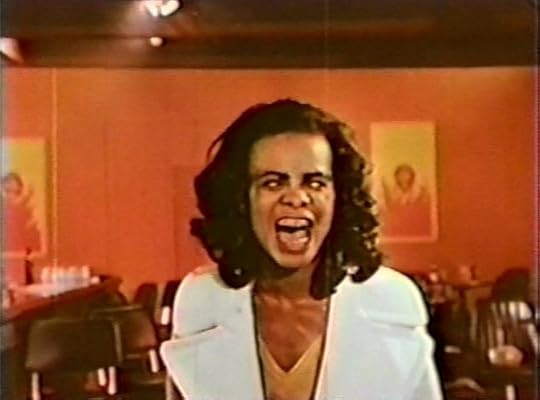 American International Pictures
American International PicturesThe horror genre at large needs its vampires and evil spirits for sure, but there’s nothing quite like a zombie flick. 1974 gave us a supremely fascinating and entertaining offering with Sugar Hill. Despite its behind-the-scenes creatives being largely white, Sugar Hill manages to tell a Black-led story that’s engaging and unique without much of the overt (and thinly veiled) racism of other horror flicks at the time. Is the representation perfect by any means? No. But it could certainly be much, much worse.
The titular character, played by Marki Bey, exacts revenge against a mob boss and his henchmen who killed her nightclub owner boyfriend Langston. Sugar goes to a voodoo queen (we love a voodoo queen) who summons Baron Samedi, the lord of the dead. Samedi raises an army of zombies to kill the mobsters. It’s an inspired premise with dialogue that is as classic Blaxploitation as it gets. Sugar Hill doesn’t lean into the excessive gore or brutality that we see in more current offerings like The Walking Dead; however, it establishes an unsettling atmosphere with its zombies.
Speaking of them, they are deceased African slaves who almost exclusively kill white people. There’s much to be said about a long lineage of Black pain, righteous anger, and, to a lesser degree, ancestral power and veneration. Bey’s Sugar Hill is one of the most badass women to ever grace a horror flick. She certainly laid the foundation for the Selenas, Michonnes, and Jerylines to come. As today’s youth would say, she was mothering.
Of course, there are other films that I won’t dive into, like the ridiculous Vampira (1974) that shows Dracula’s wife transforming into a “foxy lady” or the downright nauseating Poor Pretty Eddie (1975), with its touches of Blaxploitation and dousing of sexual assault. Gross. We can’t talk about them all, right? But we can move towards the end of the classic Blaxploitation horror era with 1976’s Dr. Black, Mr. Hyde. Under the direction of Blacula‘s William Crain, the story does an obvious play on the Jekyll/Hyde dynamic. Funnily enough, the doctor’s last name is not Black, but instead Pride (Get it?!).
He’s an LA-based wealthy gentleman who wants to cure liver cirrhosis. He experiments with potential cures on himself and attempts to force experiments on others. Pride turns into a white-skinned, freakish monster who kills sex workers and pimps before the police gun him down . Respectability issues aside, this film touches on historical and unethical experimentation against Black people. It also flips the Black-coded/othered monster trope established in earlier (and very racist) horror films on its head. Pride himself is supposed to be aspirational or a sell-out, depending on the viewers’ perspective. Predictably, (overwhelmingly white) reviewers at the time hated this film. But it continues to hold a special place in old-school horror fans’ hearts.
That adoring sentiment also exists for J.D.’s Revenge (1976). It’s a rather somber Blaxploitation horror-thriller with some serious actors in leading roles. Glynn Turman stars as the quiet law student Ike who somehow channels J.D.’s superfly spirit during a hypnosis show. Decades prior, J.D. (David McKnight) was unjustly murdered for a violent crime against his sister that he didn’t commit. As J.D. overtakes Ike, the latter begins to act uncharacteristically while also trying to solve the aforementioned crime. It’s a mental trip that moves at a slower pace yet deftly explores the devolvement of one man’s mind. Good stuff, indeed.
By the late 1970s, the Blaxploitation era as a whole began its decline; however, these films made a lasting impact on cinema. The ‘80s brought us offerings like The Last Dragon, a martial arts film with heavy Blaxploitation influence. But Black-led horror suffered despite the rise of franchises like A Nightmare on Elm Street and Friday the 13th. Many Black characters became tropes like the sidekick, Magical Negro, and sacrificial lamb. (Yes, exceptions exist, including Grace Jones’ campy Vamp (1986) and the no-good, very-bad Black Devil Doll from Hell (1984).)
Blaxploitation horror’s influence is stronger in the ‘90s and early 2000s, with the anthology series Tales From the Hood (1995), Leprechaun in the Hood (2000), Def By Temptation (1990), Candyman (1992), Vampire in Brooklyn (1995), Bones (2001) and a string of “hood” based films with titles ending in a Z (hello Zombiez). These films would explore issues affecting Black communities, like AIDS, abuse, and poverty, through the lens of scary stories. The continuous rise of hip-hop music further fueled these Blaxploitation-inspired films, with rappers Snoop Dogg, Coolio, and Ice-T stepping into acting.
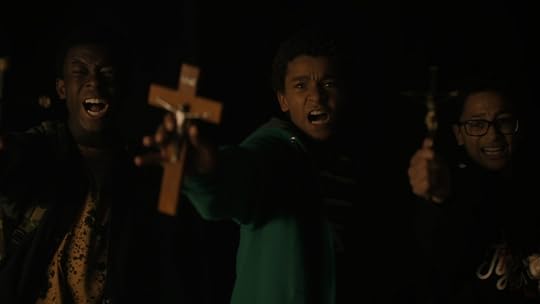
Now, it’s much more commonplace to see Black horror movies like Get Out, Us, The Blackening, The Angry Black Girl and Her Monster, Eve’s Bayou, and Vampires vs. the Bronx. There’s also the lower budget “hood” films like Amityville in the Hood (2021) and the wildly titled Bitch Ass (2022). (The latter actually isn’t as bad as you’d imagine, btw. It is not a masterpiece but better than those awful “Z movies.”)
Many Blaxploitation horror films certainly had problematic elements; however, the idea that Black stories have a place in this genre space laid a foundation for great things to come. Whether introspective, silly, or downright bizarre, Black horror stories from the 1970s were truly a special time in cinematic history.
The post A Brief(ish) History of Blaxploitation Horror Movies appeared first on Nerdist.
Chris Hardwick's Blog
- Chris Hardwick's profile
- 132 followers



